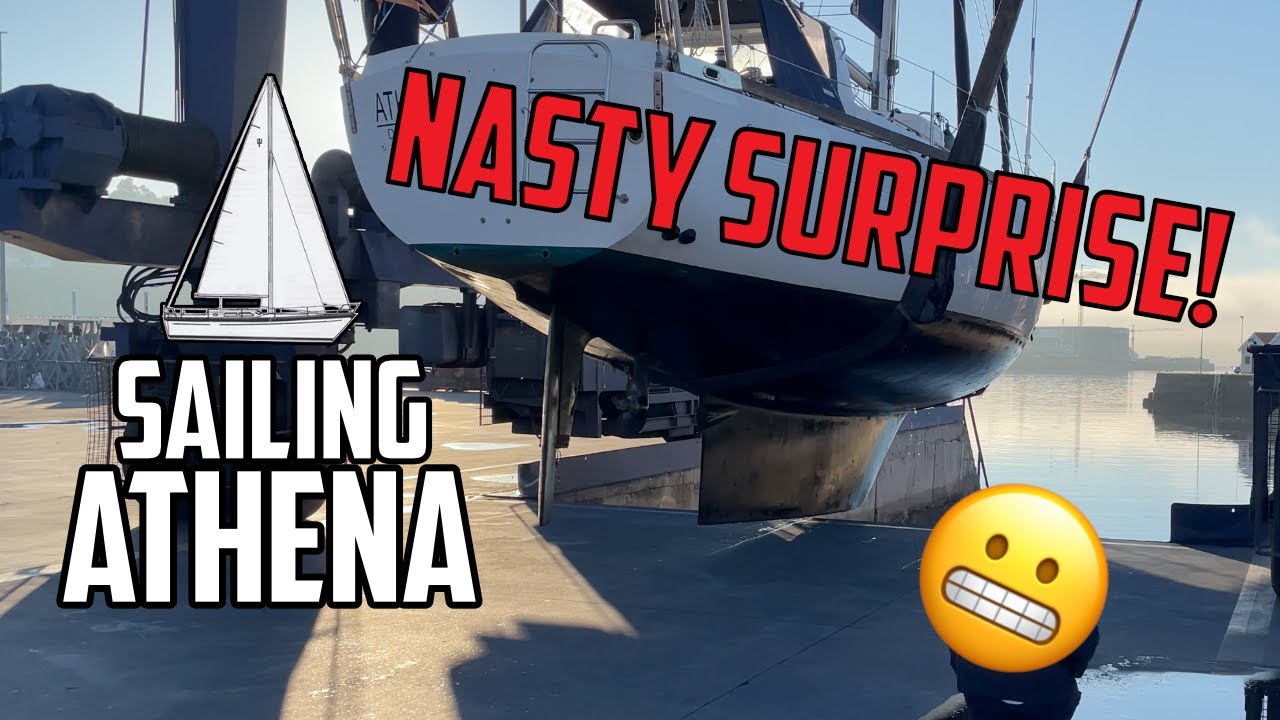Urcăm pe greu și găsim o surpriză urâtă. Seajet pellerclean: https://www.seajetpaint.com/en/products/propeller/seajet-pellerclean *** Link-uri *** Site-ul Sail Life: https://www.saillifechannel.com/ Sail Life pe Patreon: http ://bit.ly/SailLifeOnPatreon Sail Life pe Instagram: https://www.instagram.com/saillife_/ Sail Life pe Facebook: http://bit.ly/SailLifeOnFacebook Sail Life pe Twitter: http://bit. ly/SailLifeOnTwitter
source
Sail Life – Ieșire cu o surpriză urâtă 😬

41 thoughts on “Sail Life – Ieșire cu o surpriză urâtă 😬”
Comments are closed.




I imagine the second guy was right. It was a stray current. Speak to Viv Cox he’s an expert at metals, etc. also, I think you probably need to use an isolation transformer between your shore power and your internal power. But I am NOT an expert so take that suggestion with a massive grain of salt. Cheers, good luck.
have you not considered a folding propeller?
Hey guys. For the stainles. What about static electricity between the copper particals and the stanless?
I think a layer of sikaflex between the hull and stainless wil do the trick to isolate
"everyone's opinions have entered the chat" hahaha
Could it be that the foulty ram module for the autopilot created a leak current on the rudder shaft?
It's a capacitive thing. Should still be considered an earth to all other fittings.
Stainless steel and water,. I think the water got into it while your were sailing possibly in bad weather where the water was forced under it. Ive never sailed so i am noooo expert by any means. Just a maybe as to how it got like that.
A tip , Sikaflex is shit
Soudal fixall made in Belgium
I wish I’d paid attention in Spanish class too. I didn’t know we had so many Hispanics in Texas (I lived in a small town surrounded by small towns)…live and learn
How conductive is the copper coat?
Propspeed and Pellerclean are exactly the same exorbitant price in Australia. The one that doesn't work is $100 less. Your Coppercoat is very impressive after two years.
Another YT channel “Sailing Dauntless” had a corrosion problem where his sail drives were completely corroded to Swiss cheese. It had something to do with being connected to shore power and galvanic reactions.
Only the very highest grades of stainless will survive contact with warm sea water. Where you might be fine with 316 in the Baltic, the Caribbean will quickly destroy it. Bronze is the way to go.
is the rudder post grounded? even tho its not connected to it if there's any stray currents (often found in marinas apparently) it could be close enough to the rudder post to allow current to flow through it and to the rudder through the water?
Stainless steels get their corrosion resistance by the formation of a very thin surface film, called the passive film, which forms on the surface in the presence of oxygen. Therefore, stainless steels usually have poor corrosion resistance in low-oxygen environments, such as under deposits, in mud, or in tight places, called crevices, where structures or hardware are attached. This is particularly true in seawater, where the chlorides from the salt will attack and destroy the passive film faster than it can reform in low oxygen areas. All of the stainless steels except the best of the specialty alloys will suffer from pitting or crevice corrosion when immersed in seawater. One of the best 300-series stainless steels is type 316. Even this alloy will, if unprotected, start corroding under soft washers, in o-ring grooves, or any other tight crevice area in as little as one day, and it is not unusual to have penetration of a tenth of an inch in a crevice area after only 30 days in seawater. If water flows fast past a stainless steel, more oxygen is delivered to the stainless steel and it corrodes less. For this reason, stainless steels have been successfully used for impeller blades and propellers. These need to be protected from corrosion when there is no flow.
https://www.dieselduck.info/machine/04%20auxiliary/corrosion.htm
Is it odd to sleep on the hard, when the boat doesn't move at all?
Hi Athena, we have used pellerclean in the Med before and we got good results with it. Once every two or three years a new coat. It lasts. The rudder looks very much like elektrolyse due to different potential of the metals used. Very difficult to asses what did the trick. The bolts or the rings or something else. Try to use best quality 316 stainless. Lucky it did not pitted the rudder shaft itself. You also showed you use normal anti fouling over the sail drive. If there is any copper in that anti fouling that is also tricky and could pit the aluminium casing of the sail drive. It is not recommended, even with a primer in between….. Greetings Ruben
put some zincs on your boat.
Put sacrificial zinc anode on your boat.
Could the carbon fiber in rudder be related to the shoe corrosion? I know on the carbon fiber aircraft, titanium or Monel fasteners are used exclusively because they are closer together (to carbon fiber) on galvanic scale than stainless… But the rudder pivot isn't corroded so maybe it's not related at all.
Should have given the rudder shoe a coat of the prop seajet coating too. Wouldn’t hurt.
Electrical connection via the Coppercoat? Or through the sea water?
You should have a folding prop for reduced drag – expensive though! I've never had any luck with prop anti foul – the natural cavitation caused by a spinning prop blasts the coating off on all the main surfaces. As you say they are expensive as well. Regular treatment with silicone or water proof grease works to good effect although it needs regular attention. Rudder – there are loads of small anodes available or it could be a continuity issue and earthing strap requirement. I would bung on a small anode regardless and monitor it. I should ask what grade stainless it is, For that bracket you could try some seriously good stuff 318L or 2025. 316 and anything less will corrode and the copper coat could be adding to this. I know aluminium mustn't come into contact with copper coat. Bronze has been mentioned as a solution but I've not seen it in stress related application – it's too soft. Good luck on this one.
I havde en fejl i jeres autopilot styrer arm, der kan have sendt elektricitet ned gennem roret.
Could the corrosion have anything to do with the copper coat? Brilliant video. Steve.
It is likely both crevice corrosion and galvanic corrosion as stated below. Any type of stainless should not be used in a submerged environment. It would be much better to used bronze instead, as long as it is screwed into a compatible insert of sorts.
As for the noise from the rudder area while underway; it could be from the propeller spinning freely while underway, which you would not hear while the engine is running. Also the prop is spinning backwards so any wear in the bearing while going forward, may cause a bit more interference while spinning in reverse. Try pinning the propeller shaft while under sail and see if you can still hear the sound.
The steering system is isolated ? Can the energy flows trough the rudder axe ?
Mads. I was a bit surprised that you pointed you anchor drain cover downwards and to the stern. On my HR34 the cover just points sternwards. You might find that when you pitch up and down that you might force water into the locker even though you are moving forwards. Bw John
That is basically the smoothest and easiest-looking prop removal I've ever seen. Well done with whatever you lubricated it with at assembly; this is DEFINITELY the desired result.
Ground the SS "shoe".
Hi @Sail Life! We had a similar issue with the heel strap on our Island Packet 35, only ours was more severe. Our electrician noted that the pitting(or cratering) we had on 1 seacock and our heel strap, was a sure sign DC stray current corrosion. We had similar corrosive issues on our stainless steel bolts and washer which evaporated as your had. What we found was that one of our 2-0 ground wires started to fail which was putting a bit of resistance in our DC circuit. This caused stray DC Curren to flow out through our engine and prop, which became a giant cathode. Since our rudder post was bonded, as was 1 of seacocks (weirdly, the other two seacocks were left off of the bonding loop), they became the anode as the DC current used them as the path back to the source, our more specifically, our batteries.
Is your rudder post bonded? If so, you might want to poke around with a multimeter and check for the potential of a grounding issue, even if it is just for peace of mind.
What grade of stainless was it made from? Make the next one out of 316 stainless and keep away any other type of metal from it. That will solve the problem.
Somethings happenning to seawater when it gets hotter. More agressive. Stainless is not a good material. If its passivated it's around copper in the galvanic voltage sequence. If the warm seawater get it depassified it convert into an anode. My own experience with stainless steel parts as nippels and valves is they last about 3 months in the return plastic pipe from seawater coling to buildings. This is hotter than the intake water.
I wonder how long your prop paint withstands cavitation.
Hi Eva og Mads
I am very excited to hear how your propeller will look like in the future.
I consider myself to have invented the best product ever.
It is cheap, it does not pollute the environment and it is very easy to work with.
Clean the surface of the propeller.
Sanding the propeller so you can see yourself in it.
Boil a kettle of water and add a lot of salt.
Paint the propeller many times with the saltwater solution.
The propeller gets ugly, but that's the point.
The salt has drawn copper to the surface of the propeller, it has turned green.
No fouling.
Try it, it's almost free.
The product can also be sold in beautiful bottles, but then it becomes expensive!
Steen from back home in Skive
Love your channel!
Not all stainless is equivalent, even when it says it is… We've have 'guaranteed' 316 hose clamps fail at the screw, because the screw was from a different supplier. We've had 1000m pressure rated wet connects fail at the 316 fitting because the male end was isolated from the case (which had zinc placed far more regular than necessary) and the two parts, though both very expensive 'guaranteed' 316, were just "ever so slightly" not… If there is any dissimilar metals, the ocean will make a dielectric of some potential. Use teflon spacers and coated fasteners, the cheap route, or source all metal from a supplier that guarantees the steel properties. That used to be easy, but now you have to verify (going back to the hose clamps, same US vendor for years, then all the sudden). Or, just bite the really big bullet and use titanium everywhere!
Can the stainless have functioned as an anode to the coppercoat?
Good luck and safe sailing to you both xx
Attach rudder strap to ground through 12 gauge solid copper wire place zinc on top of stainless run wire back to battery ground done deal